Charles E W Bean, Diaries, AWM38 3DRL 606/260/1 - 1916 - 1930 - Part 20
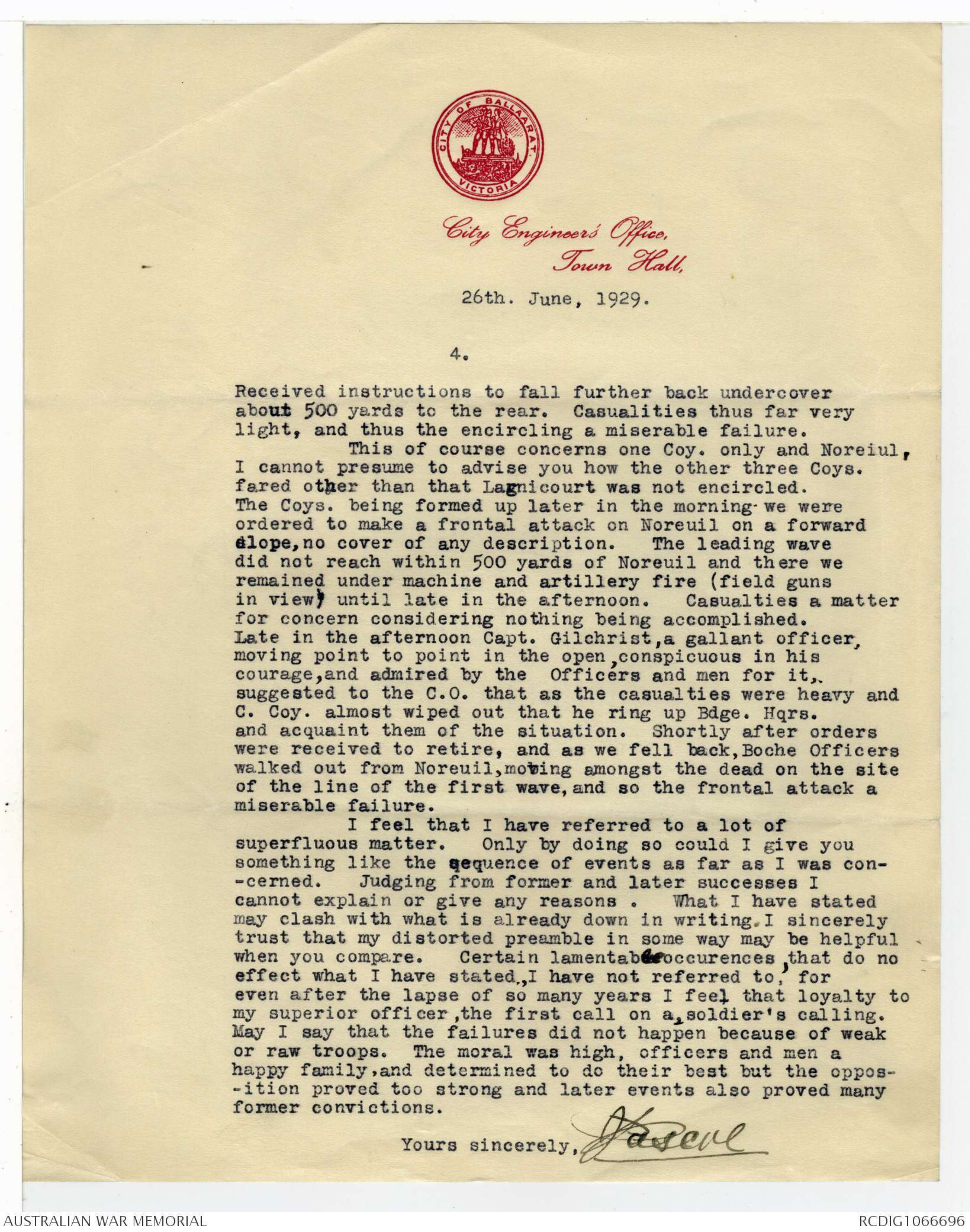
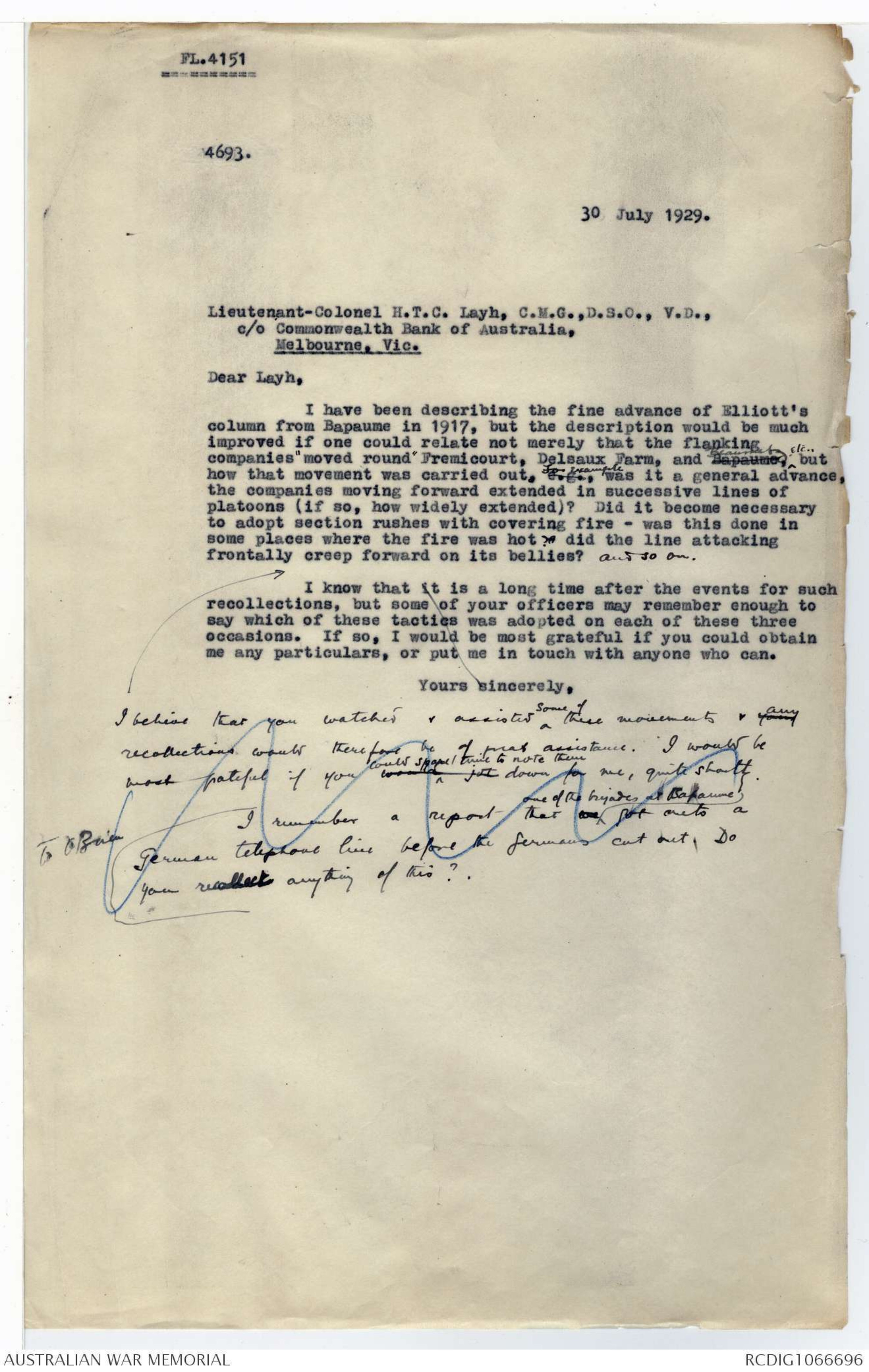
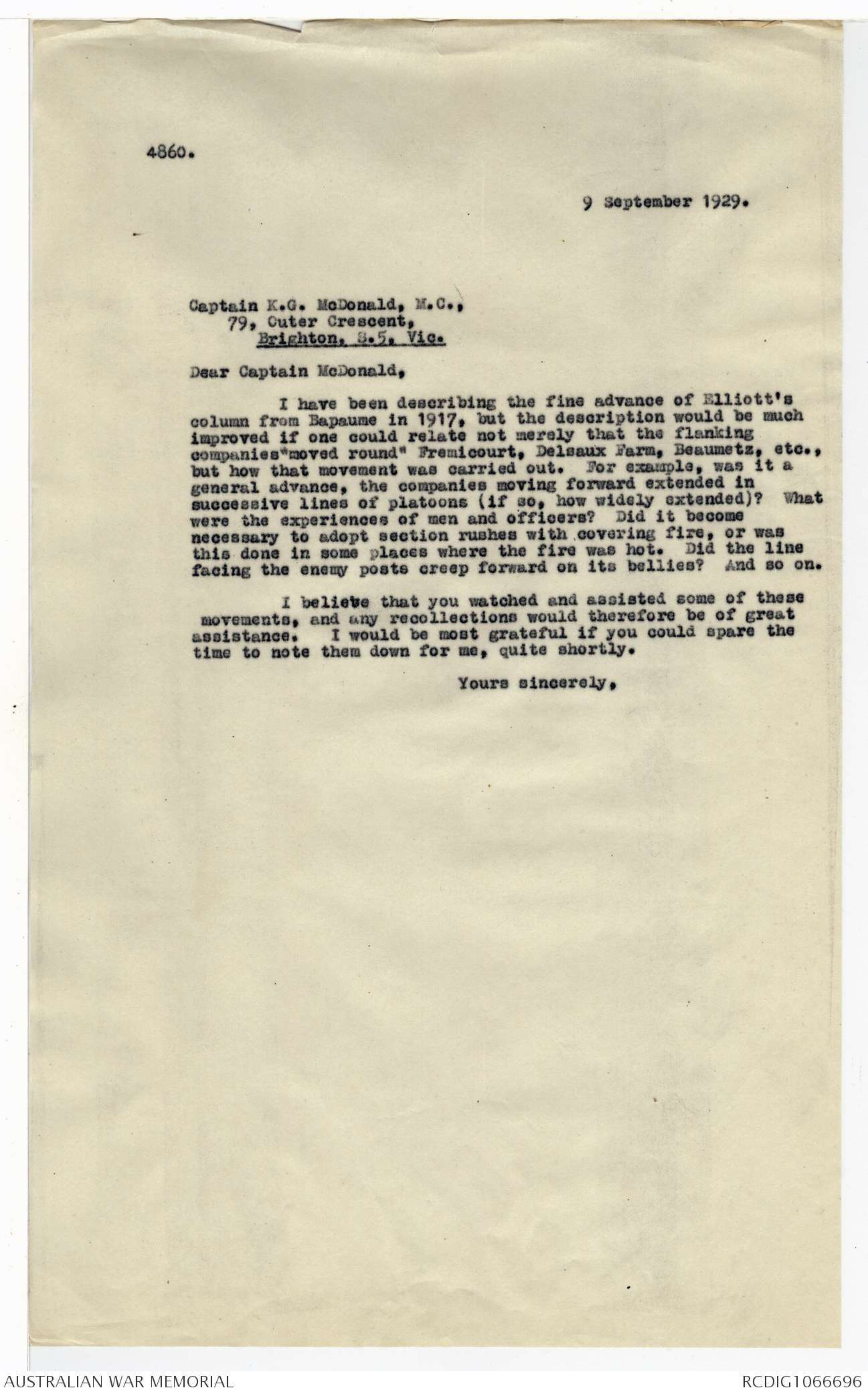
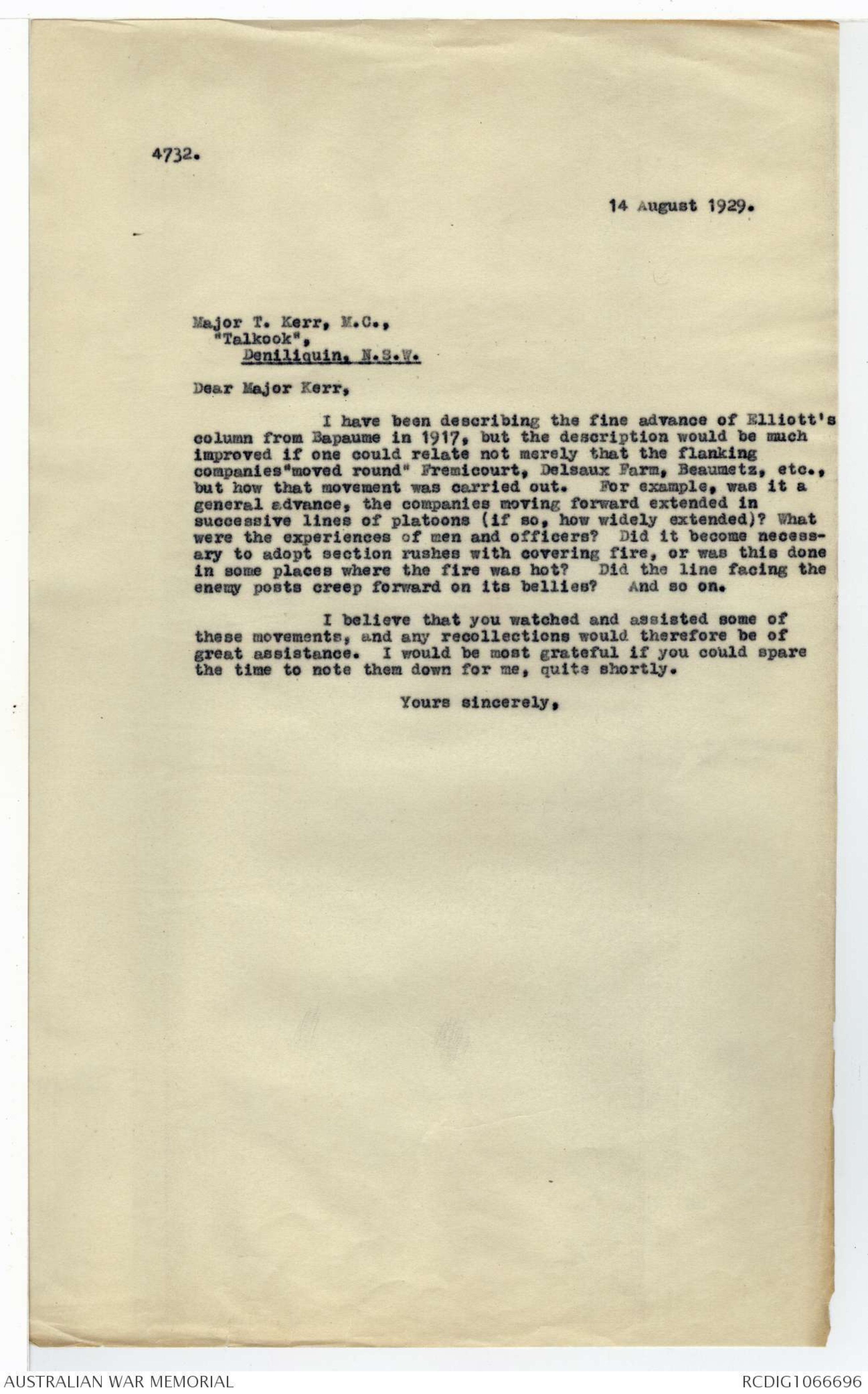
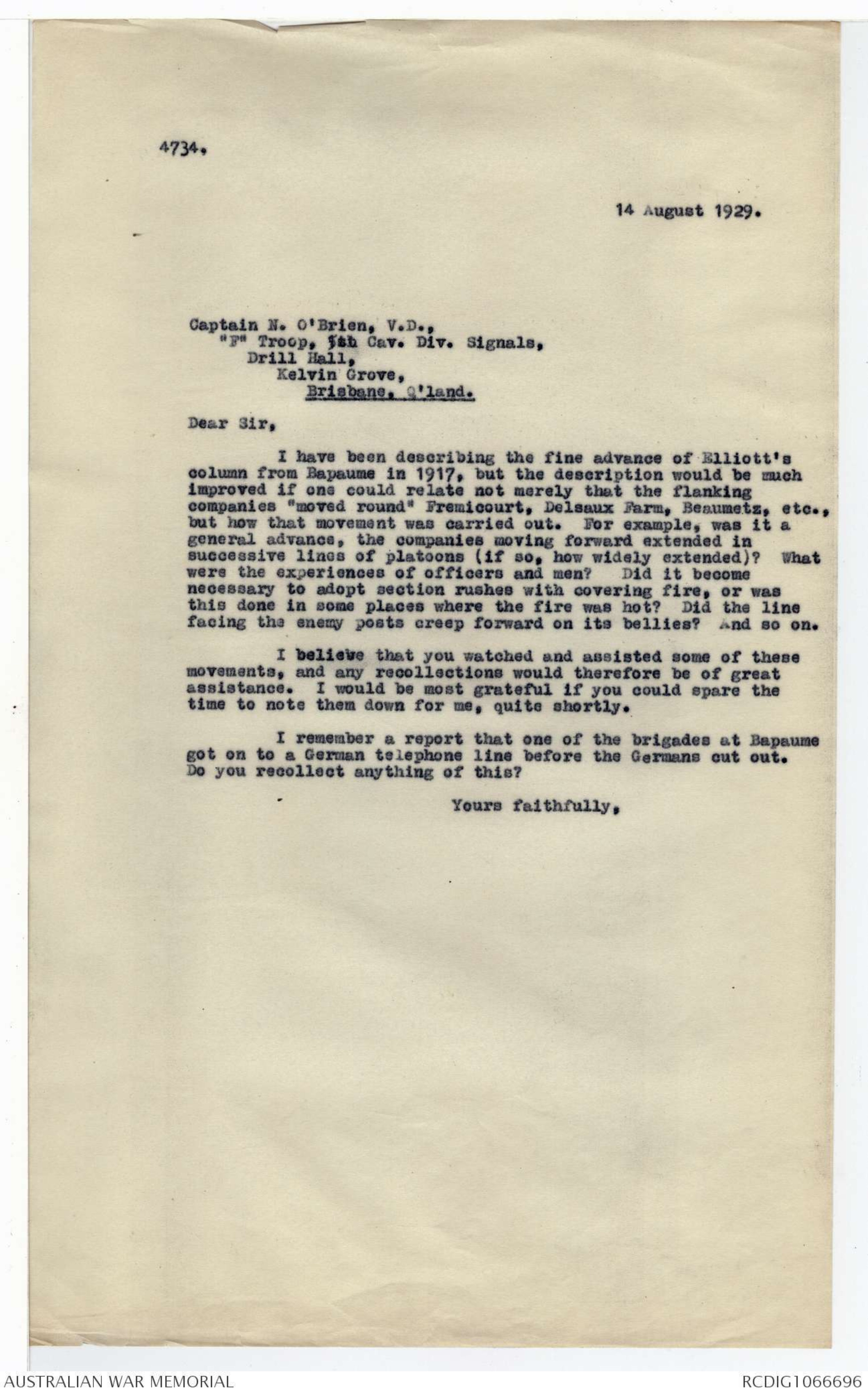
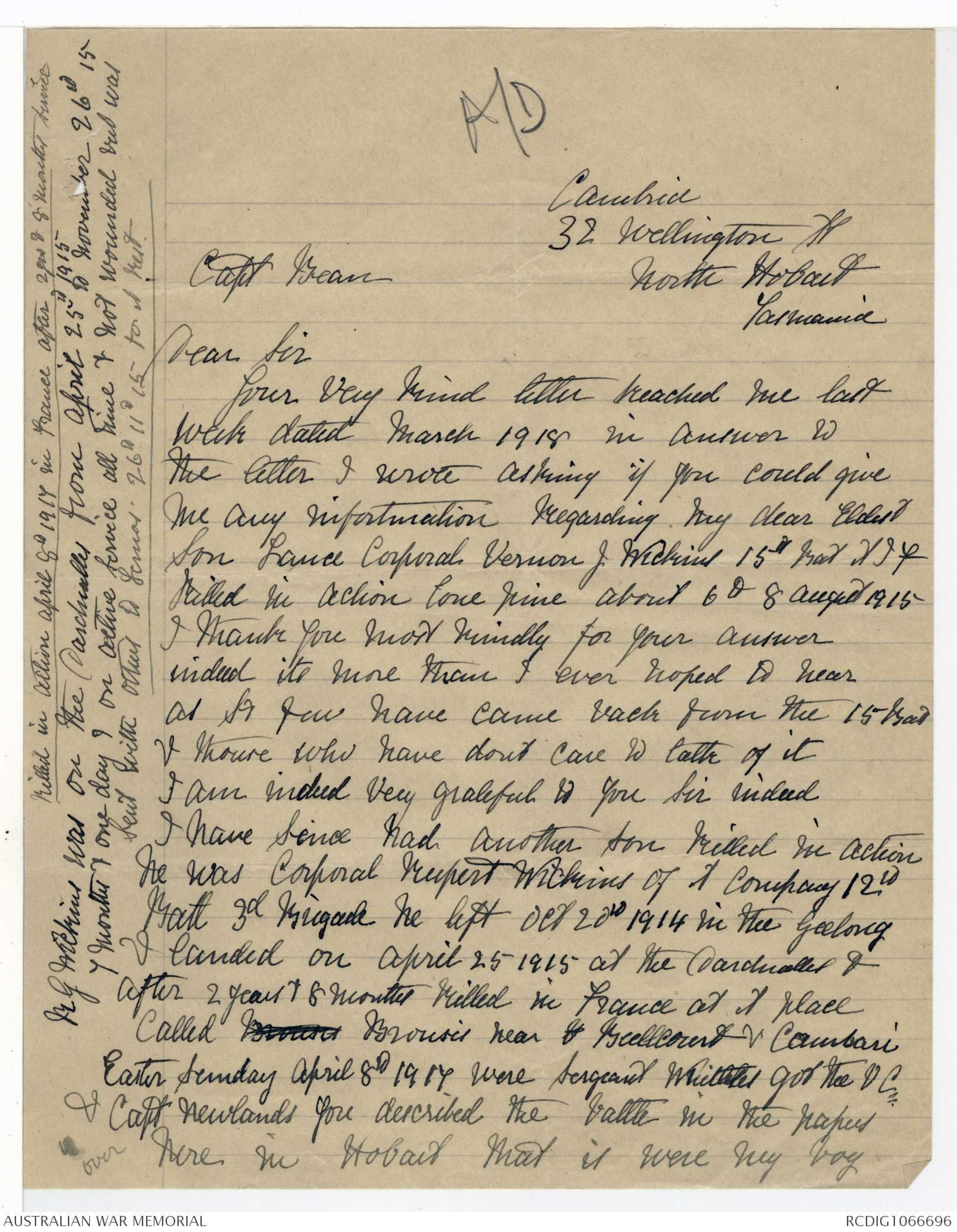
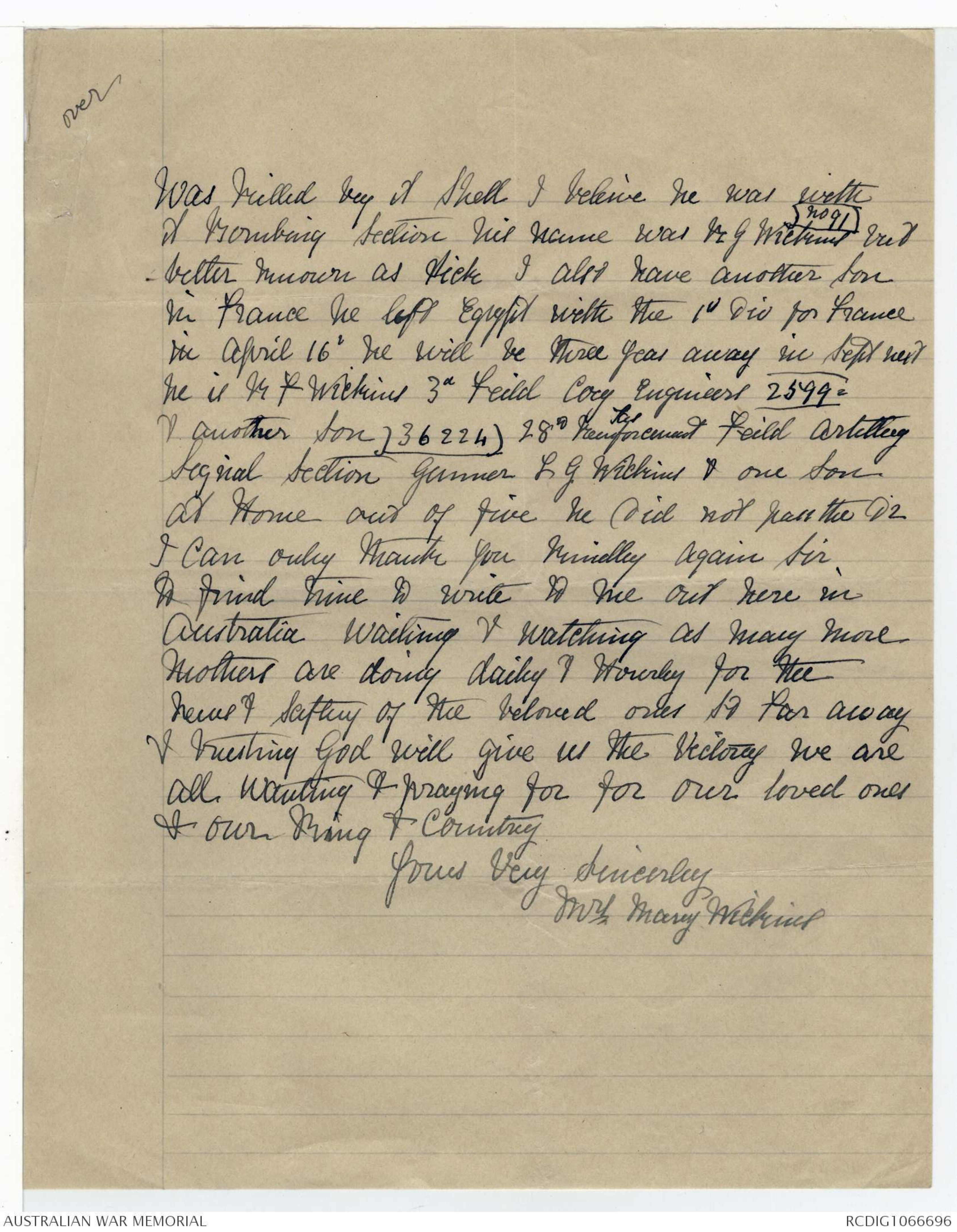

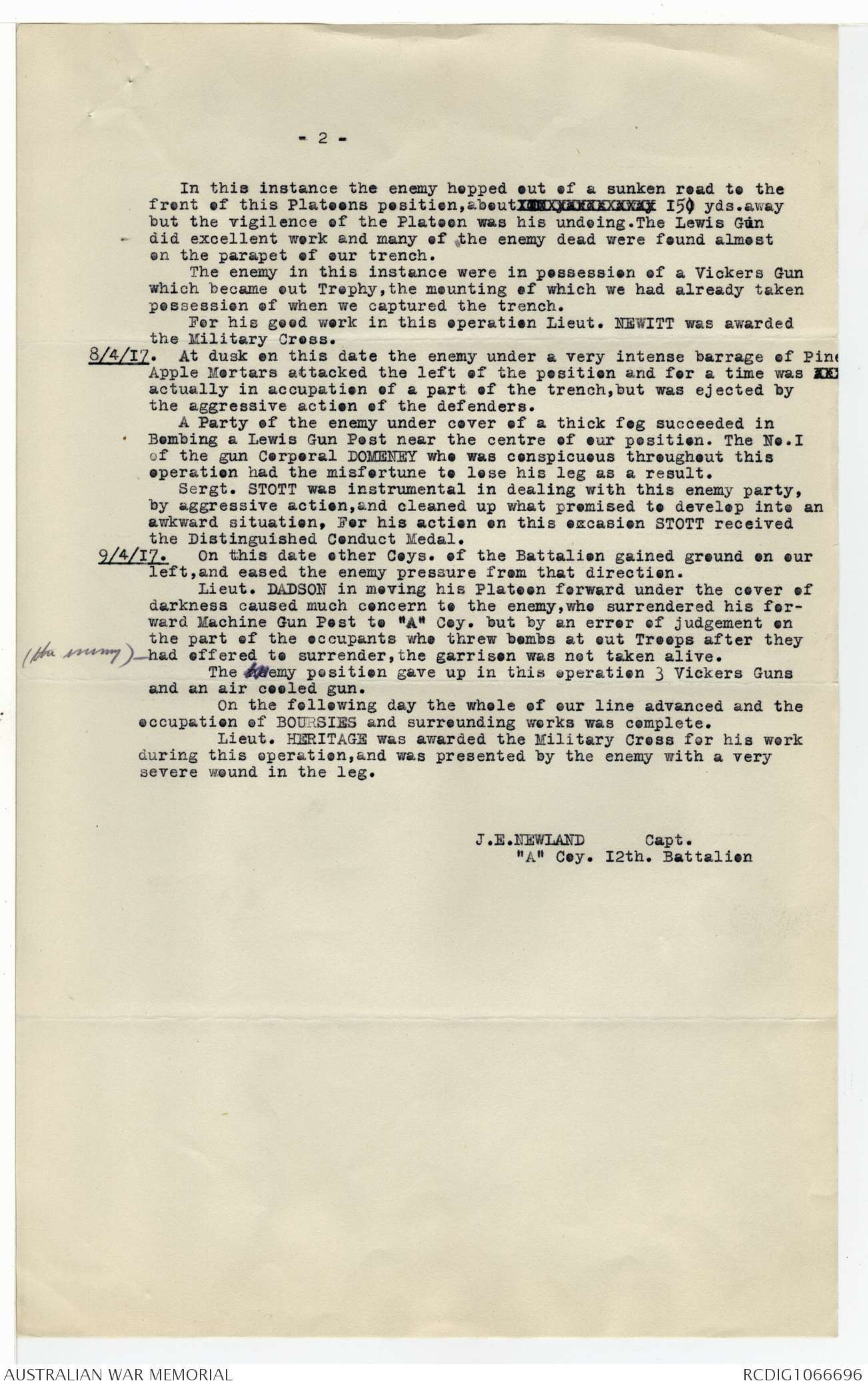
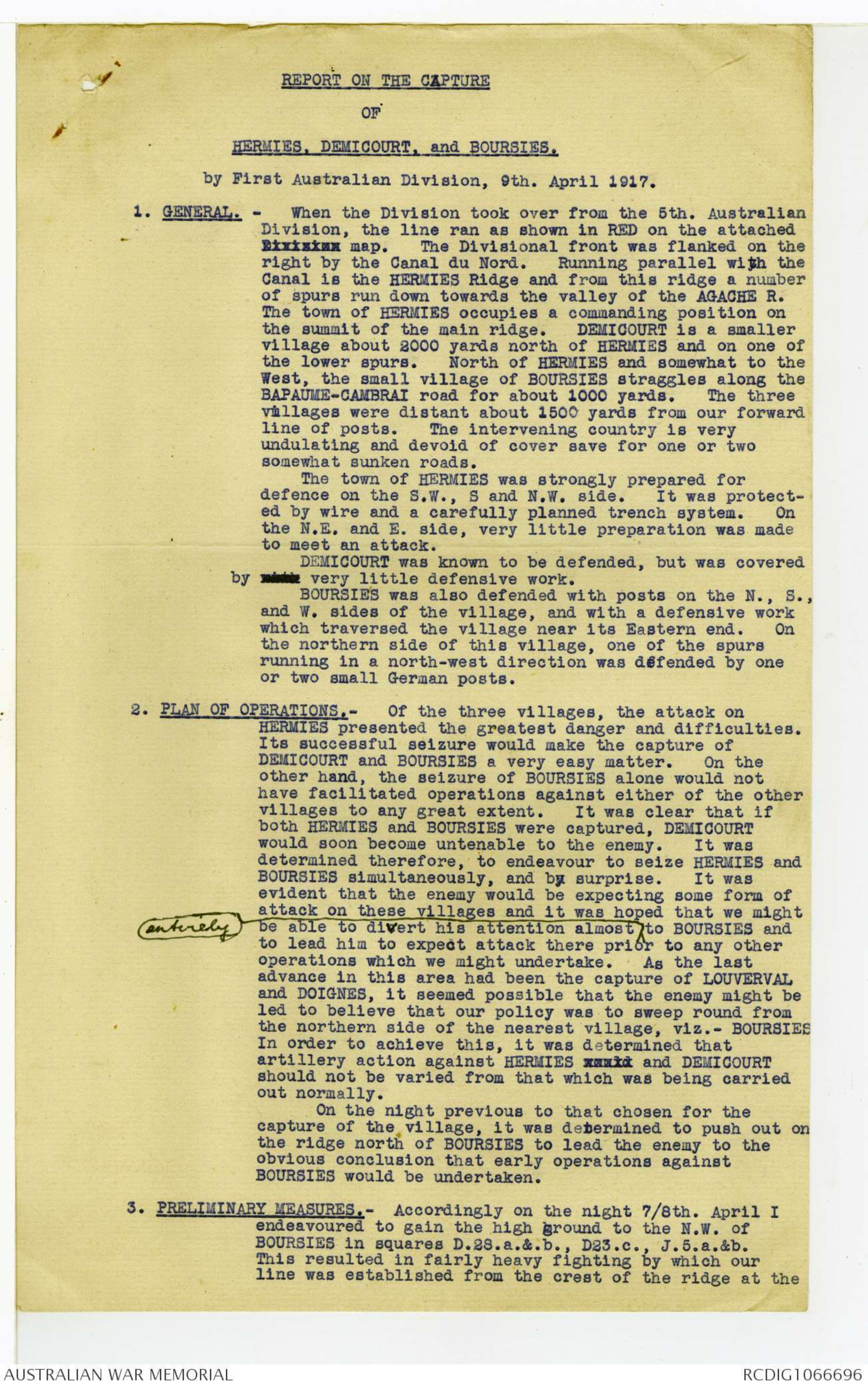
CITY OF BALLARAT
VICTORIA
City Engineer's Office,
Town Hall,
26th. June, 1929.
4.
Received instructions to fall further back undercover
about 500 yards to the rear. Casualties thus far very
light, and thus the encircling a miserable failure.
This of course concerns one Coy. only and Noreiul,
I cannot presume to advise you how the other three Coys.
fared other than that Lagnicourt was not encircled.
The Coys. being formed up later in the morning we were
ordered to make a frontal attack on Noreuil on a forward
slope, no cover of any description. The leading wave
did not reach within 500 yards of Noreuil and there we
remained under machine and artillery fire (field guns
in view) until late in the afternoon. Casualties a matter
for concern considering nothing being accomplished.
Late in the afternoon Capt. Gilchrist, a gallant officer,
moving point to point in the open, conspicuous in his
courage, and admired by the Officers and men for it,
suggested to the C.O. that as the casualties were heavy and
C. Coy. almost wiped out that he ring up Bdge. Hqrs.
and acquaint them of the situation. Shortly after orders
were received to retire, and as we fell back, Boche Officers
walked out from Noreuil, moving amongst the dead on the site
of the line of the first wave, and so the frontal attack a
miserable failure.
I feel that I have referred to a lot of
superfluous matter. Only by doing so could I give you
something like the sequence of events as far as I was
concerned. Judging from former and later successes I
cannot explain or give any reasons. What I have stated
may clash with what is already down in writing. I sincerely
trust that my distorted preamble in some way may be helpful
when you compare. Certain lamentable occurrences, that do no
effect what I have stated., I have not referred to, for
even after the lapse of so many years I feel that loyalty to
my superior officer, the first call on a soldier's calling.
May I say that the failures did not happen because of weak
or raw troops. The moral was high, officers and men a
happy family, and determined to do their best but the opposition
proved too strong and later events also proved many
former convictions.
Yours sincerely, JA [[Lasuel?]] [[_aseve?]]
FL.4151
4693.
30 July 1929.
Lieutenant-Colonel H.T.C. Layh, C.M.G.,D.S.O.. V.D.,
c/o Commonwealth Bank of Australia,
Melbourne, Vic.
Dear Layh,
I have been describing the fine advance of Elliott's
column from Bapaume in 1917, but the description would be much
improved if one could relate not merely that the flanking
companies "moved round" 'Fremicourt, Delsaux Farm, and Bapaume ∧ Beaumetz etc., but
how that movement was carried out, e.g. ∧ for example, was it a general advance,
the companies moving forward extended in successive lines of
platoons (if so, how widely extended)? Did it become necessary
to adopt section rushes with covering fire - was this done in
some places where the fire was hot? did the line attacking
frontally creep forward on its bellies? and so on.
I know that it is a long time after the events for such
recollections, but some of your officers may remember enough to
say which of these tactics was adopted on each of these three
occasions. If so, I would be most grateful if you could obtain
me any particulars, or put me in touch with anyone who can.
Yours sincerely,
(*I believe that you watched & assisted ∧ some of these movements and your any
recollections would therefore be of great assistance. I would be
most grateful if you would jot ∧ could spare time to note these down for me, quite shortly.
I remember a report that are ∧ one of the brigades at Bapaume got on to a
German telephone line before the Germans cut out. Do
you recollect anything of this?.
(*CW Bean*)
4860.
9 September 1929.
Captain K.G. McDonald, M.C.,
79, Outer Crescent
Brighton, S.5. Vic.
Dear Captain McDonald,
I have been describing the fine advance of Elliott's
column from Bapaume in 1917, but the description would be much
improved if one could relate not merely that the flanking
companies "moved round" Fremicourt, Delsaux Farm, Beaumetz, etc.,
but how that movement was carried out. For example, was it a
general advance, the companies moving forward extended in
successive lines of platoons (if so, how widely extended)? What
were the experiences of men and officers? Did it become
necessary to adopt section rushes with covering fire, or was
this done in some places where the fire was hot. Did the line
facing the enemy posts creep forward on its bellies? And so on.
I believe that you watched and assisted some of these
movements, and any recollections would therefore be of great
assistance. I would be most grateful if you could spare the
time to note them down for me, quite shortly.
Yours sincerely,
4732.
14 August 1929.
Major T. Kerr, M.C.,
"Talkook"
Deniliquin, N.S.W.
Dear Major Kerr,
I have been describing the fine advance of Elliott's
column from Bapaume in 1917, but the description would be much
improved if one could relate not merely that the flanking
companies "moved round" Fremicourt, Delsaux Farm, Beaumetz, etc.,
but how that movement was carried out. For example, was it a
general advance, the companies moving forward extended in
successive lines of platoons (if so, how widely extended)? What
were the experiences of men and officers? Did it become
necessary to adopt section rushes with covering fire, or was this done
in some places where the fire was hot? Did the line facing the
enemy posts creep forward on its bellies? And so on.
I believe that you watched and assisted some of
these movements, and any recollections would therefore be of
great assistance. I would be most grateful if you could spare
the time to note them down for me, quits shortly.
Yours sincerely,
4734.
14 August 1929.
Captain N. O'Brien, V.D.,
"F" Troop. 5th Cav. Div. Signals,
Drill Hall,
Kelvin Grove,
Brisbane, Q'land.
Dear Sir,
I have been describing the fine advance of Elliott's
column from Bapaume in 1917, but the description would be much
improved if one could relate not merely that the flanking
companies "moved round" Fremicourt, Delsaux Farm, Beaumetz, etc.,
but how that movement was carried out. For example, was it a
general advance, the companies moving forward extended in
successive lines of platoons (if so, how widely extended)? What
were the experiences of officers and men? Did it become
necessary to adopt section rushes with covering fire, or was
this done in some places where the fire was hot? Did the line
facing the enemy posts creep forward on its bellies? And so on.
I believe that you watched and assisted some of these
movements, and any recollections would therefore be of great
assistance. I would be most grateful if you could spare the
time to note them down for me, quite shortly.
I remember a report that one of the brigades at Bapaume
got on to a German telephone line before the Germans cut out.
Do you recollect anything of this?
Yours faithfully,
[*A/D*]
Cambria
32 Wellington St
North Hobart
Tasmania
Capt Bean
Dear Sir
Your very kind letter reached me last
week dated March 1918 in answer to
the letter I wrote asking if you could give
me any information regarding my dear Eldest
Son Lance Corporal Vernon J. Wickins 15th Bat AIF
killed in action Lone Pine about 6th or 8 August 1915
I thank you most kindly for your answer
indeed its more than I ever hoped to hear
as so few have came back from the 15 Bat
& those who have dont care to talk of it
I am indeed very grateful to you Sir indeed
I have Since had another son killed in action
He was Corporal Rupert Wickins of A Company 12th
Batt 3rd Brigade He left Oct 20th 1914 in the Geelong
& landed on April 25 1915 at the Dardnelles &
after 2 years & 8 months killed in France at a place
called Brousis Brousis near B Bullcourt & Cambari
Easter Sunday April 8th 1917 were Sergeant Whittle got the VC.
& Capt Newlands You described the battle in the papers
[*over*] here in Hobart that it were my boy
Following written vertically on left side of page.
[*Killed in action April 8th 1917 in France after 2yrs & 8 Months Service
R G Wickins was on the Dardenelles from April 25th 1915 to November 26th 15
7 months & one day & on active Service all time & not wounded but was
sent with others to Lemnos 26th 11th 15 for a rest.*]
[*over*]
was killed by a shell I beleive he was with (No91)
a Bombing Section his name was R G Wickins but
better known as Pick I also have another Son
in France he left Egypt with the 1st Div for France
in April 16th he will be three year away in Sept next
he is R F Wickins 3rd feild Coy Engineers 2599
& another son 36224 28th xx Reinforcement Feild Artillery
Signal Section Gunner L G Wickins & one Son
at home out of five he did not pass the Dr
I can only thank kindly again Sir
to find the time to write to me out here in
Australia waiting & watching as many more
mothers are doing daily & hourly for the
news & safety of the beloved ones so far away
& trusting God will give us the Victory we are
all wanting & praying for for our loved ones
& our King & Country
Yours Very Sincerley
Mrs Mary Wickins
H.N/. From Capt NEWLAND
12 Bn
12th. Battalion. A.I.F.
Account of Operations BOURSIES 7 - 9th April 1917.
BOURSIES
7/4/17 This date found the Battalion occupying front line sector in
front of BOURSIES, this village was about 900 yds. distance and on
the Main road BUPUME-CAMBRAI. THE Battalion front was inclusive of
the road and with the exception of a small post immediately on
the right of the road, the Battalion extended in a succession of
posts from the road to about 5000 500× yds. on the left.
Small observation posts were pushed out to the front and a good
amount of patrolling was done forward of and between the posts.
The enemy was equally alert, and his patrols were very often
sighted. One of the enemy patrols actually approached one of our
posts, and endulged in an exchange of hand grenades.
In anticipation of an early move forwrd everyone was very alert,
and constantly reported movements of the enemy, and the probable
location of Machine Guns.
Enemy Machine Guns having been located in a Mill, immediately on
left of the road BAPUME-CAMBRAI, and at the edge of BOURSIES VILLAGE
action was taken to communicate this intelligence to the Field
Artillery, which shelled and demolished the Mill.
Orders having been issued that the enemy position at the near
edge of BOURSIES VILLAGE was to be occupied during night 7-8th.
April, "A" Company was detailed for the task. The Company Commander
(Capt. J.E. NEWLAND) had placed at his disposal also One Platoon of
"B" Company under Lieut. R. NEWITT
The Platoons of "A" Coy. at this time were Commanded by Lieuts.
HERITAGE, SHERWIN, KELLY, while Sergt. J. WHITTLE as was usually the case
had charge of a Platoon.
The plan of the attack was as simple as it was successful.
Lieut. NEWITT was to move with his Platoon to the right of the
position to be attacked, and await the time for the advance which was
set down for 3 a.m. and to be made without any Artillery preparation.
"A" Coy, was to attack direct from the front.
The movement of Lieuts NEWITTS Platoon was up a convex slope
and was to continue 'till it incurred Machine Gun Fire from the attacked
position, and then to go to earth, and remain for the time being,
protected by the curviture of the ground.
The action of this Platoon as was anticipated, drew the fire of
the Enemy Machine Guns directly in front of "A" Coy. which rushed
the position from the front.
A Bombing Party moved forward immediately on the left of the
road and made the Mill their objective.
So keen were the Platoons on the capture of the Mill position
that they actually reached the position a few moments before the
bombers, and in response to the explosion of one of the bombers hand
grenades in the Mill Lieut. KELLY who had actually gained the position
rushed out of the Mill amidst a cloud of brick dust.
Thus the position was gained, and the eagerness of the Troops carried
them well into the Village of BOURSIES, which was beyond the objective,
and from which they were afterwards withdrawn.
Amongst our losses the writer can well remember Lieut. SHERWIN,
Sergts. SCOTT and YOUNG and Private McPHERSON all of whon had rendered
exceptionally good service throughout.
Let us now revert to the Platoon of "B" Coy. under Lieut. NEWITT
which we have lying "Doggo" on the right of this position.
This Platoon had carried out their instructions to the very letter
and up to this time had incurred no casualties.
This Platoon was now advanced and occupied the enemy trench on
the right of Road BUPUME-CAMBRAI where they on the following day did
excellent service in repelling the enemy who in a misguided moment
endeavoured to regain their lost territory.
In.
(* N.W of Rd*)
2 -
In this instance the enemy hopped out of a sunken read to the
front of this Platoons position, about 100 yards away 150 yds. away
but the vigilence of the Platoon was his undoing. The Lewis Gun
did excellent work and many of the enemy dead were found almost
on the parapet of our trench.
The enemy in this instance were in possession of a Vickers Gun
which became out Trophy, the mounting of which we had already taken
possession of when we captured the trench.
For his good work in this operation Lieut. NEWITT was awarded
the Military Cross.
8/4/17. At dusk on this date the enemy under a very intense barrage of Pine
Apple Mortars attacked the left of the position and for a time was act
actually in accupation of a part of the trench, but was ejected by
the aggressive action of the defenders.
A Party of the enemy under cover of a thick fog succeeded in
Bombing a Lewis Gun Post near the centre of our position. The No.I
of the gun Corporal DOMENEY who was conspicuous throughout this
operation had the misfortune to lose his leg as a result.
Sergt. STOTT was instrumental in dealing with this enemy party,
by aggressive action, and cleaned up what promised to develop into an
awkward situation, For his action on this occasion STOTT received
the Distinguished Conduct Medal.
9/4/17. On this date other Coys. of the Battalion gained ground on our
left, and eased the enemy pressure from that direction.
Lieut. DADSON in moving his Platoon forward under the cover of
darkness caused much concern to the enemy, who surrendered his forward
Machine Gun Post to "A" Coy. but by an error of judgement on
the part of the occupants who threw bombs at out Troops after they
(the enemy)-had offered to surrender, the garrison was not taken alive.
The enemy position gave up in this operation 3 Vickers Guns
and an air cooled gun.
On the following day the whole of our line advanced and the
occupation of BOURSIES and surrounding works was complete.
Lieut. HERITAGE was awarded the Military Cross for his work
during this operation, and was presented by the enemy with a very
severe wound in the leg.
J.E. NEWLAND Capt.
"A" Coy. I2th. Battalion
REPORT ON THE CAPTURE
OF
HERMIES, DEMICOURT, and BOURSIES,
by First Australian Division, 9th. April 1917.
1. GENERAL. - When the Division took over from the 5th. Australian
Division, the line ran as shown in RED on the attachedDivision map. The Divisional front was flanked on the
right by the Canal du Nord. Running parallel with the
Canal is the HERMIES Ridge and from this ridge a number
of spurs run down towards the valley of the AGACHE R.
The town of HERMIES occupies a commanding position on
the summit of the main ridge. DEMICOURT is a smaller
village about 2000 yards north of HERMIES and on one of
the lower spurs. North of HERMIES and somewhat to the
West, the small village of BOURSIES straggles along the
BAPAUME-CAMBRAI road for about 1000 yards. The three
villages were distant about 1500 yards from our forward
line of posts. The intervening country is very
undulating and devoid of cover save for one or two
somewhat sunken roads.
The town of HERMIES was strongly prepared for
defence on the S.W., S and N.W. side. It was protected
by wire and a carefully planned trench system. On
the N.E. and E. side, very little preparation was made
to meet an attack.
DEMICOURT was known to be defended, but was covered
by xxxxx very little defensive work.
BOURSIES was also defended with posts on the N., S.,
and W. sides of the village, and with a defensive work
which traversed the village near its Eastern end. On
the northern side of this village, one of the spurs
running in a north-west direction was defended by one
or two small German posts.
2. PLAN OF OPERATIONS.- Of the three villages, the attack on
HERMIES presented the greatest danger and difficulties.
Its successful seizure would make the capture of
DEMICOURT and BOURSIES a very easy matter. On the
other hand, the seizure of BOURSIES alone would not
have facilitated operations against either of the other
villages to any great extent. It was clear that if
both HERMIES and BOURSIES were captured, DEMICOURT
would soon become untenable to the enemy. It was
determined therefore, to endeavour to seize HERMIES and
BOURSIES simultaneously, and by surprise. It was
evident that the enemy would be expecting some form of
attack on these villages and it was hoped that we might
be able to divert his attention almost ∧ entirely to BOURSIES and
to lead him to expect attack there prior to any other
operations which we might undertake. As the last
advance in this area had been the capture of LOUVERVAL
and DOIGNES, it seemed possible that the enemy might be
led to believe that our policy was to sweep round from
the northern side of the nearest village, viz.- BOURSIES
In order to achieve this, it was determined that
artillery action against HERMIES would and DEMICOURT
should not be varied from that which was being carried
out normally.
On the night previous to that chosen for the
capture of the village, it was determined to push out on
the ridge north of BOURSIES to lead the enemy to the
obvious conclusion that early operations against
BOURSIES would be undertaken.
3. PRELIMINARY MEASURES.- Accordingly on the night 7/8th. April I
endeavoured to gain the high ground to the N.W. of
BOURSIES in squares D.28.a.&.b., D23.c., J.5.a.&b.
This resulted in fairly heavy fighting by which our
line was established from the crest of the ridge at the
 Sandy Mudie
Sandy MudieThis transcription item is now locked to you for editing. To release the lock either Save your changes or Cancel.
This lock will be automatically released after 60 minutes of inactivity.